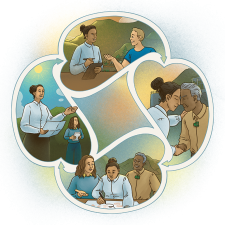1. Foundations | Te tūāpapa
Ko ō tātou whakapono ngā kaiwehewehe i a tātau.
Ko ō tātau moemoeā me ō tātau pākatokato ngā kaiwhakakotahi i a tātau.
It is our truths that are the actors of separation.
It is our dreams and diffi culties that act to unify us.
– Te Wharehuia Milroy
On this page
 In this chapter, you will learn:
In this chapter, you will learn:
- What just transitions are
- The context for just transitions in Aotearoa
- The importance of Te Tiriti o Waitangi
- Principles from te ao Māori
In this section
Why we need just transitions
Transitions mean fundamental changes to systems.
What are just transitions?
Just transitions bring people together to transform disruptive change into positive change.
The importance of Te Tiriti o Waitangi
In Aotearoa New Zealand, there is a national framework that applies in a just transition process: Te Tiriti o Waitangi.
Principles from te ao Māori the Māori worldview
Te ao Māori can help shape just transition processes to better address complex problems.

